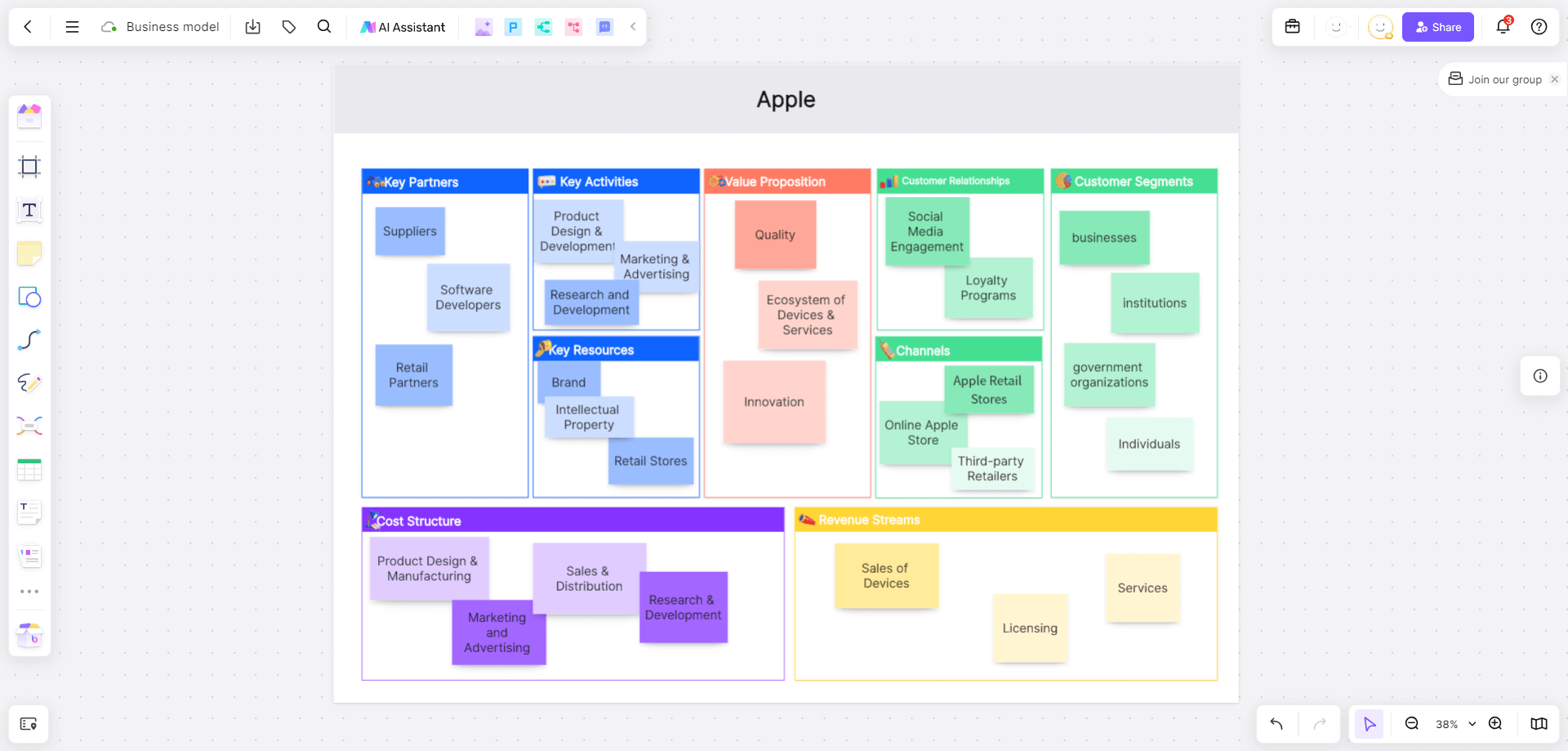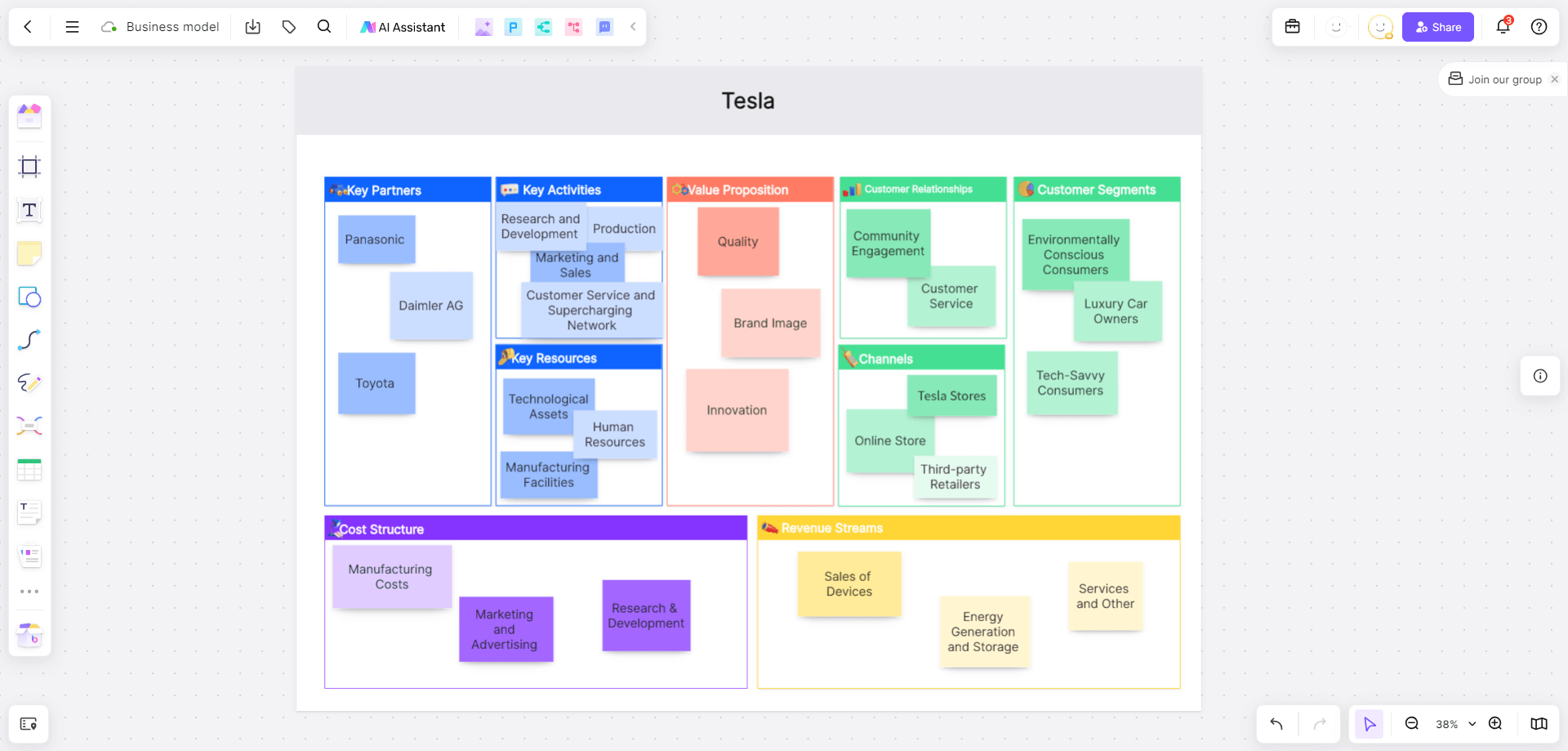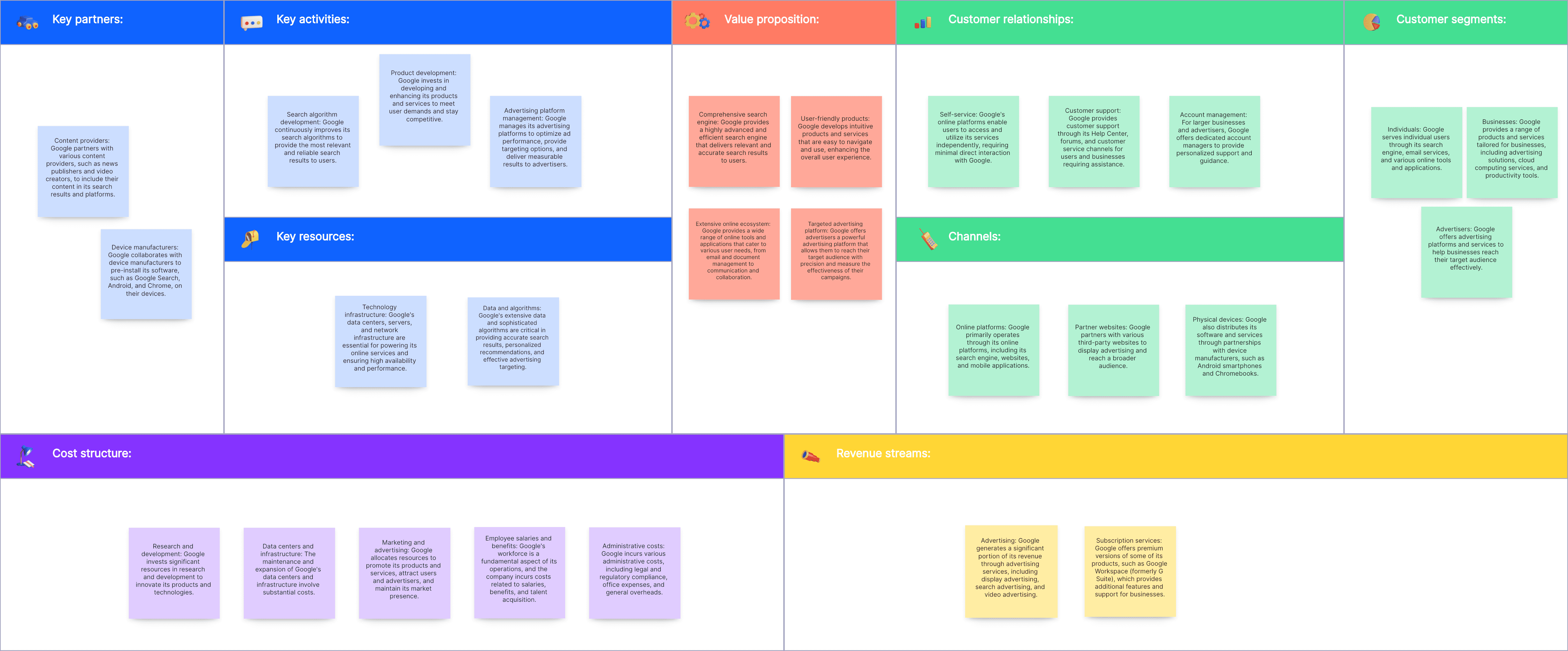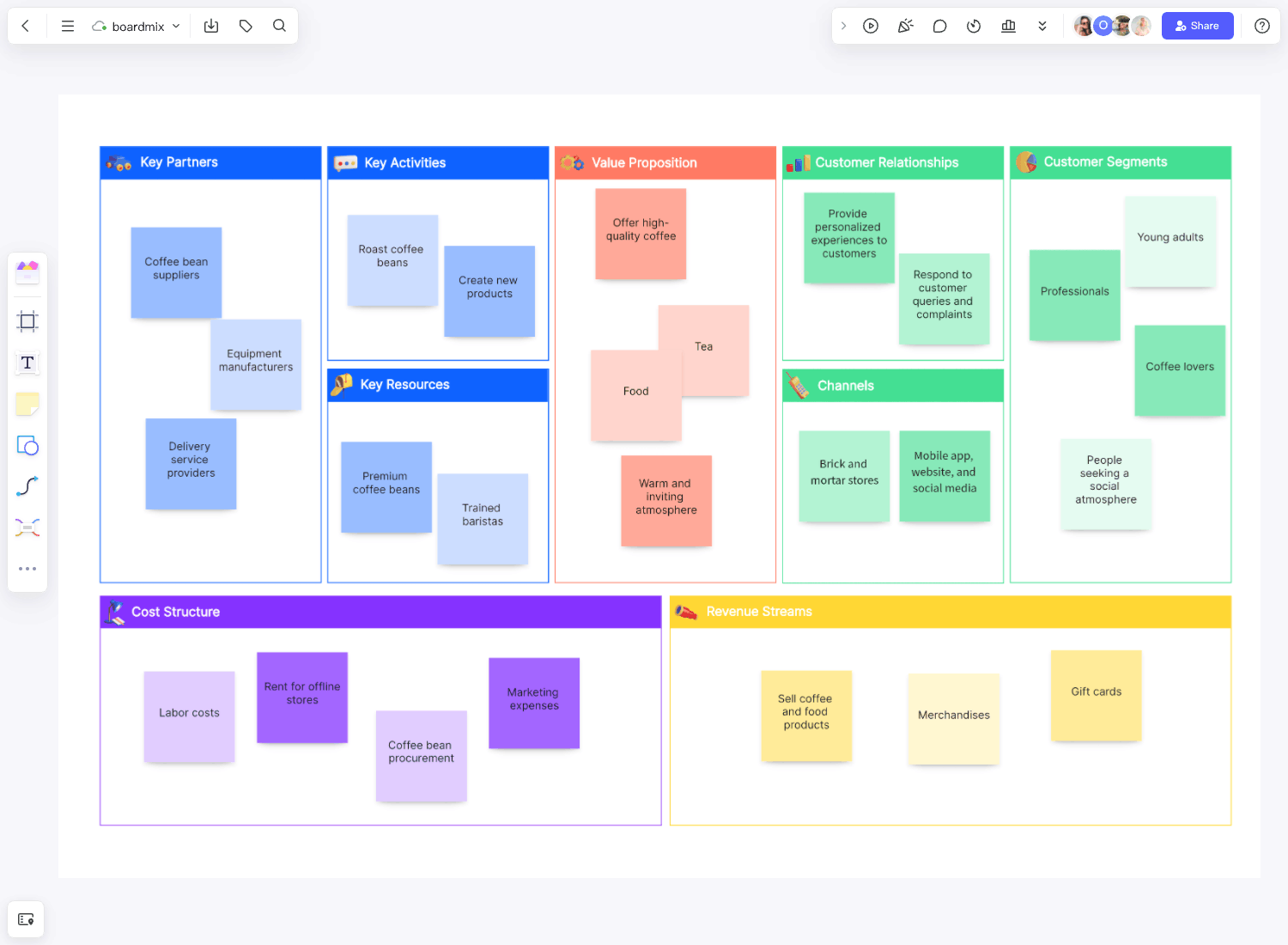Embarking on a business venture is exhilarating yet seldom effortless. Initially deceptive in simplicity, it swiftly reveals multifaceted layers demanding profound contemplation. The array of considerations and avenues to traverse can swiftly overwhelm. Consequently, a structured approach becomes imperative, often initiated by crafting a comprehensive business model canvas. This foundational tool offers clarity, enabling strategic navigation through the intricate journey of entrepreneurship.
What Is a Business Model Canvas?

Build Business Model Canvas for Free
Not to be confused with a business plan, the business model canvas is a cruder, more candid version of a business plan. It may very well be the predecessor as most successful business plans originate from a well-crafted business model canvas.
Functioning as a strategic compass, it spotlights vital business components, fosters informed operation and steers towards a positive trajectory. The construction of a comprehensive business model canvas entails skillfully addressing demanding inquiries, thereby facilitating the meticulous identification, insightful analysis, and strategic optimization of pivotal facets, ultimately paving the path to sustainable success.
It was conceptualized by Swiss business specialist Alexander Osterwalder and Belgian computer scientist Yves Pigneur and is now regarded as one of the most critical tools for building a new business, as well as for upgrading an existing one.
When to Use a Business Model Canvas?
The idea of a business model canvas seems very simple but it is remarkably multifaceted and can be used for numerous applications. A lot of business managers now use a business model canvas template to upgrade their existing business strategies or create new ones that will take the business forward. Many aspiring business owners also use a business model canvas template to lay out their ideas for more efficient planning and eventual implementation.
A slightly less common way of using a business model canvas template is when you want to read into your competitors. Instead of creating your business model, you can then make one for your top industry rivals. Also, while it is meant for summarizing the key elements of a business, it can work just as well for analyzing a product.
What Are the 9 Parts of the Business Model Canvas?
No matter which business model canvas template you end up using, all of them would include the 9 parts of the model, as determined by Osterwalder and Pigneur.
Key Partners
It is impossible to run a business on your own, even for a sole proprietorship. There will always be other entities involved, like vendors and suppliers, advisors and mentors, distributors and delivery service providers, accountants and lawyers – the list goes on. All these are your key partners for your business.
Key Activities
These are all the vital activities that must be carried out so that you can achieve the ultimate goal of your business. These activities are mostly done by you, although your key partners might also have a critical role in some of them. Some of the typical activities are procurement of supplies or raw materials, design and production of products, distribution to various sales channels, and so on.
Key Resources
A key resource is anything owned or controlled by your business that is instrumental in its success. This would include machinery and equipment, formulas and patents, and other business assets that are used in any of the operations. Even your personnel or staff are considered key resources to your business. The list is not confined to tangible items either, because things such as experience and expertise are also among the key resources of a business, and are in fact among the most important ones.
Value Propositions
Many would say that value propositions are the highlight of the business model canvas template, and they won’t be wrong. Value propositions are what you hope to give to your customers. It is based on this single element that strategies are created and business operations are executed. In identifying the core value proposition of your business, you need to figure out what problem you wish to solve for your customers or which of their needs you wish to fulfill.
Customer Relationships
These are all the interactions between your business and the customers. Some businesses are more hands-on in delivering their services, which creates more interactions with the clients and often on a deeper level. Others are not as involved and simply make their services or products available, and let the customers take their pick.
Channels
The channels in a business model canvas template pertain to how your business delivers its value propositions to the clients. These are usually composed of a network of multiple parts working together to ensure that the customer’s demands and needs are adequately met.
Customer Segments
While some businesses have a very specific target market, most actually serve a broad range of clientele. In the customer segments section of the business model canvas template, you must list all the types of customers that you aim to serve.
Cost Structure
We now come to the financial aspect of the business. Cost structure refers to all the expenditures of the business and how they are addressed. This is largely dependent on whether your business is cost-driven, where the focus is to minimize costs, or value-driven, where the focus is to maximize value.
Revenue Streams
The revenue streams are the sources of cash flow for your business or simply put, where the money comes from. Not that there could be more than one revenue stream. A good business model canvas template would have several revenue streams to maximize business income. It is also this section that covers the payment methods that your business accepts from customers.
Benefits of Using a Business Model Canvas
Using a business model canvas can do a business a lot of good, although some think it is a redundant process and goes directly to creating the business plan. But if you take the time to use a business model canvas, here are some of the valuable benefits that you can enjoy.
Stay Focused on Core Value
Dozens of things can affect the course of a business. While all these things do have an impact, some of them can distract you from what is important. In using a business model canvas, one of the elements you would identify is the core value proposition, and that is exactly where your focus should be.
Have Structure and Flexibility
A business model canvas template puts all your ideas into an organized format, giving structure to a lot of brilliant but chaotic ideas. At the same time, the model also allows for flexibility, letting you make necessary adjustments if changing situations call for it.
Maintain Transparency
The business model canvas template allows everyone involved in the business to be fully aware of everything in the operation of the business. This makes for a better understanding of all the concepts and processes and allows for more informed team discussions that can further improve the business model.
Business Model Canvas Templates in Boardmix
1. Apple Business Model Canvas
Apple Inc. is a world-renowned technology company that delivers creative and aptly differentiated products for a global audience. The business model utilizes an effective framework, ensuring that the brand maintains its reputation as an industry leader.
This section presents the canvas for Apple’s business model created using the Boardmix productivity platform.

Build Business Model Canvas for Free
2. Tesla Business Model Canvas
While the Tesla business model canvas may encompass several sections, it fundamentally relies on three distinct pillars: servicing, selling model, and charging network. These core foundations are intricately woven into Tesla’s operational framework, ensuring efficient maintenance and support services, an innovative selling model tailored to the electric vehicle market, and a comprehensive charging network that underpins the convenience of Tesla’s vehicles for customers.

3. Google Business Model Canvas
The diversity that Google offers is in line with the company’s mission of organizing the world’s information. It aims to make data universally accessible to those who need it. The brand keeps winning these days, and it’s all thanks to the highly efficient business model canvas of Google.
Here is an overview of the template brought to you by the Boardmix productivity platform. You can quickly follow the details of this canvas in one glance!

Build Business Model Canvas for Free
How to Use the Business Model Canvas Template
It is very easy to use the business model canvas template – the challenge lies more in thinking of what to put into each of the sections of the template. Here at Boardmix, our business model canvas template has a single-page layout that clearly shows all the 9 key elements. On the top part of the template, we have the first 7 elements in our list, with the value proposition appropriately in the middle spot. The lower part is reserved for the cost structure and revenue streams.
Step 1: Log in to Your Boardmix Account
To begin, you'll need to access your Boardmix account. Go to the Boardmix website and enter your login credentials. If you don't have an account yet, you can sign up for a new one for free.

Step 2: Search and Choose Business Model Canvas Template
Once you're logged in, head over to the Template library. You can find this in the main dashboard. Search for the business model canvas Template and click to use it for free.

Step 3: Customize and Edit Your Own Business Model Canvas
Now that you've chosen the template, it's time to customize it according to your needs. You can use shapes, lines, drawing pens, icons, and other tools to decorate your template. The business model canvas Template comes with several sections that you can fill out:
The flexibility of Boardmix allows you to add or remove sections as needed. Simply click on a component to edit it.
Step 4: Save Your Work, Share and Collaborate
When customizing your business model canvas Template, Boardmix autosaves your progress, but it's good practice to manually save before exiting.

Next, share your business model to collaborate with your team. Click on the "Share" button on the top right corner of the screen, copy the sharing link, and send it to anyone whom you want to collaborate with. People can join this file to edit and collaborate on this file in real-time by clicking this sharing link. We encourage your team to leave comments, suggest edits, or ask questions online so you can adjust it in time.
FAQs about the Business Model Canvas
What is a business model?
A business model is a tool used for identifying and illustrating all the key elements of a business. It is frequently used as the basis of the business plan.
What is the purpose of a business model canvas?
The business model canvas aims to provide a visual representation of the key elements of a business, which is useful for starting a new business or improving an existing one.
Why is a business model canvas important?
A business model can help management come up with new and better strategies to boost performance. It can attract investors and top talent into the company. It can also serve as motivation to everyone involved in the business.












